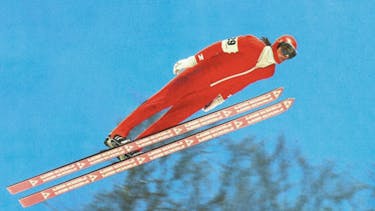„FISCHER WAS THE DRIVING FORCE BEHIND THE AUSTRIAN SKI JUMPERS.”
In the 1970s Toni Innauer was a member of the miraculous Austrian ski jumping team. The man from Vorarlberg reached the zenith of his career when he won a gold medal at the 1980 Olympics in Lake Placid. After an ankle injury put an untimely end to his athletic career, Innauer worked for the Austrian Ski Federation as a trainer and director of sport. In 2011 Innauer launched the agency Innauer+(f)acts. Innauer on the “market leader” Fischer: “Fischer sped development up and was escort to and the driving force behind the Austrian ski jumpers.”
How did you get into ski jumping?
Via classmates from school. And because I happened to have time on my hands after not being nominated for the Austrian skiing championships.
What is so fascinating about ski jumping?
Finding a system capable of flying with your own body and loosely attached skis – but you have to keep learning for years, and you’re bound to fail in the early stages.
What was Fischer’s significance in your career?
Fischer sped development up and was escort to and the driving force behind the Austrian ski jumpers who launched a new culture in competitive sport under the guidance of Baldur Preiml in Stams. For me as a trainer and director of sport, Fischer was a reliable partner in the equipment field who also encouraged up-and-coming youngsters.
What keywords occur to you when you think of Fischer?
High quality, reliability, market leader in ski jumping. Franz Neuländtner, who has been responsible for this area for years. And fantastic tennis rackets, in the days when they were part of the product range.
What were the highlights in your sporting career, for you personally? Two world records, the first ski jumper to be awarded five times 20 points by the judges, the victory in Holmenkollen, Olympic silver and Olympic gold in individual contests, tennis champion of Bregenzerwald with a Fischer racket (laughs).
How did you experience the shift in the various styles of ski jumping?
For me as ski jumper changing to holding your arms further back on the inrun was initially a question of nerve, but feasible within a few weeks. As the Austrian team’s trainer I didn’t actually invent the V style, but I did recognise it as the way forward and switched to it with our ski jumpers (at considerable risk) in the 1992 Olympic season. The reward was five out of a possible seven medals in Albertville in 1992. Plus a bottle of bubbly from the inventor of this remarkable technique: Jan Bokloev, the father of the V style, brought it round to our team quarters the morning after the celebrations for Ernst Vettori’s Olympic victory.
How do you see the development of ski jumping over the past 50 years?
A demanding and fascinating discipline has conquered the place it deserves in the world of winter sports, and held it for years. Even in Austria, where it was exceptionally difficult because Alpine skiing is traditionally dominant. In 2014 another milestone was reached in Sochi, when the first Olympic medals were awarded to women ski jumpers. I feel proud to have been involved in several of these developments in various different functions.
Do you enjoy thinking back to your days as an active ski jumper? Most of all together with companions from our exciting pioneering time. And repeatedly as a keynote speaker and seminar trainer, when I have the privilege of recounting and interpreting what I personally experienced and suffered as a competitive skier. That’s a huge treasure chest, from which I can extract any number of handy examples to point up how things work in business and professional life.
„THE PARTICULAR SKI WAS MUCH FASTER THAN ANYTHING I'D STOOD UP TILL THEN.”
What links do you have to the world of competitive sport even today?
With our agency Innauer+(f)acts OG we also help athletes to enhance their surroundings in terms of competitive sport and business. As a consultant I’m engaged (in the background) by policy-makers and associations, and I also cover selected events as an expert on ski jumping for ZDF and as a commentator for newspapers.
Any anecdotes from your experience with Fischer that you would like to tell us?
My first jump as a test pilot for the prototype of the first Fischer ski for jumping was on the “Rudolfschanze” hill in Mühlbach am Hochkönig. That particular ski was much faster than anything I’d stood on up till then. I jumped beyond the record, was unable to stay in balance (I was so surprised and shocked) and unintentionally drifted off to the right into deep snow, where I disappeared in a great cloud of powdery snow. At the 1980 Olympic Games in Lake Placid Gerhard Thaller of Fischer told me, one day before the contest, that I was free to switch to Kneissl. At that stage Fischer was struggling to keep abreast of the competition. I was the last of all those starting to stay with the Fischer skis, in those days bright red, which I was so attached to. All the others had lost faith in them in the course of the last season. I staked everything on a single card, because a change in temperature had been forecast, and stuck with the skis from Ried that I was so used to. The next day the Kneissl service man, who would have been delighted to put me on the yellow skis with the star, couldn’t believe his eyes: the temperature had gone up ten degrees, and with good jumps, a light wind and (at last) reasonable speed on the inrun the only man to start on Fischer skis won the gold medal! Pepi Fischer then insisted on coming past to congratulate me personally, wrapped in his legendary fur coat. Last summer I returned the compliment and visited him at his marvellous home on Attersee – but I did so without the fur coat.




